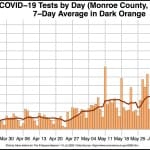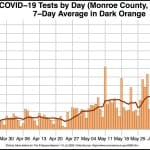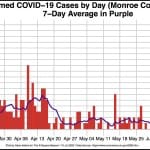Monroe County, Bloomington officials working towards a single mask rule for COVID-19, precise nature of rule still unclear




Will the rules on masks in the next Monroe County health order include a strict mandate for wearing face coverings when in public? Maybe.
During Friday’s weekly press conference, held by local leaders about the community’s COVID-19 response, city and county officials stayed squarely on message: They’re hoping to have a single rule for the entire county.
It’s less certain what that rule will be. City officials are pushing for the consistent rule to be something fairly robust. Bloomington’s mayor, John Hamilton, said that he and other city officials think “having a substantial mandate is a prudent thing to do.”
At Wednesday’s meeting of the county commissioners, Monroe County’s health administrator, Penny Caudill, had previewed the idea that some kind of mask requirement would be in the county’s next health order.
Based on Caudill’s remarks at Friday’s press conference, it’s still not settled what that requirement will look like.
Caudill recognized that support for a mask mandate in the county is strong, but said it’s is not universal. “We recognize there are a large number of people who are supportive of a mask requirement, and some people wish it was in place back in March,” Caudill said.
Caudill added, “Others are clearly letting us know that they are not in support of that. So we do hope to find some balance as we look at best public health practice around face coverings.”
The next health order from health officer Thomas Sharp is expected before the end of the month, Caudill confirmed on Friday.
A new health order, without a mandatory mask wearing requirement, was issued starting July 4. That order will stay in effect, “until repealed or replaced.”
One possible date for the next order could be July 21, based on tentative information shared at the Bloomington city council’s work session, held just before the press conference. That’s also the date when the county board of health next meets.
Caudill confirmed Friday that the seven-member bipartisan board of health does not need to vote to approve the order—the authority to issue emergency orders rests with the health officer. But the board has provided input on previous orders, she said.
If the county’s health order does not include a mask requirement that city officials think is strong enough, then either Bloomington’s city council or the mayor, through an executive order, could impose a separate city mask mandate. At Friday’s press conference, Hamilton said he would be more inclined to work with the city council on that as opposed to just using an emergency power.
In his remarks, Hamilton stressed that he is hoping for a consistent rule across the county. “Everybody is working to see if we can have a consistent rule, because I think that is easier for the population as a whole,” Hamilton said.
There appears to be a sentiment among some city councilmembers that if the county’s next health order does not include a strong enough mask requirement, then they’d like to see the city council enact a city ordinance.
About the need for a mask wearing requirement, councilmember Susan Sandberg said: “We simply have to.” She said what she hears from constituents is: “Why the delay?” Sandberg cited Indiana University’s recently announced mask mandate for campus in support of her position.
Confirming the campus mask mandate at Friday’s press conference was Kirk White, who is IU’s assistant vice president for strategic partnerships. White said the university will be providing two masks for all faculty, staff and students. The new masks are expected to be mailed to faculty and staff in the first part of August. Students will get them on arrival, White said.
Sandberg said she wants to see a general mask requirement “sooner rather than later.” Her preference appears to be that the county’s next health order include a strong mask requirement, so that there’s no need for the city to enact a separate ordinance: “We’ve got to start rowing in the same direction.” Still, she said, “I’m ready to do whatever the city needs to do.”
City attorney Mike Rouker was asked at the city council’s work session if he could put together a draft of city mask ordinance. Rouker said there are several examples of ordinances that have been written in other places, so he could turn something around around fairly quickly. But he added, “There’s a desire to avoid conflicting regulations—for the folks who have to enforce the regulations, and for those who have to comply with the rules.”
Rouker told councilmembers that based on his conversations with county officials he thinks their idea is for the next health order to include a mask wearing mandate.
At Friday’s press conference, Caudill said that mask wearing is important for preventing the spread of COVID-19, whether there is requirement for it, or if it’s just recommended. Wearing a mask when adequate distance can’t be maintained is “just a personal action that we should all be taking,” Caudill said.
“It’s what what we’ve really been striving for all along is to get people to understand the importance of that, and to do it on their own and that a mandate isn’t required,” Caudill said.
Is the specter of two different local mask regulations—if the county’s new health order is not strong enough to suit city officials—a factor that’s being considered in the crafting of the county’s health order?
Asked that question at the press conference, Caudill pointed to a different consideration that’s driving the content of the order: “As things change and we prepare for an increased population, and increased activity, and schools reopening, and businesses reopening, and all of those things, it does change things when we see positive cases increasing—that’s really what’s driving it.”
By the numbers, here’s what the recent increase in cases looks like in Monroe County.
The 14 new confirmed positive COVID-19 cases reported for July 9 in Monroe County put the 7-day rolling average at around 9 confirmed cases per day. That’s about 3 more cases per day than the highest 7-day rolling average back in April.
The total number of confirmed COVID-19 cases in Monroe County now stands at 329.
The increased raw number of confirmed cases comes in the context of increased numbers of tests in the county. Hospitalizations and deaths in the county are not showing an increase similar to the higher number of confirmed cases.
That’s similar to the statewide picture: Confirmed positive cases are showing increased numbers, along with higher testing numbers, while death numbers and hospitalizations continue to decline.
But a key stat shows that not all of the increased confirmed positive cases can be chalked up to increased testing numbers.
The rolling 7-day rolling average rate of positive tests—the percentage of tests that come back positive for COVID-19—has increased in Monroe County from under 2 percent on June 26 to around 5 percent through about July 6.
The number of tests reported for each date on the state’s COVID-19 dashboard comes with a caveat about the “preliminary” nature of the positive rate calculations. That’s why testing charts produced by The Square Beacon trim the three most recent days from the display.




Comments ()